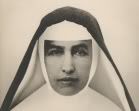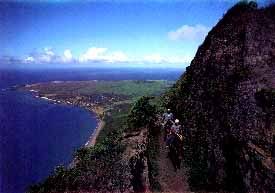Mother Marianne Cope: Once a Saint Always a Saint
Last evening my wife attended the farewell service for Mother Marianne Cope of Kalaupapa.
 Sister Marianne
Sister Marianne
Born in 1838, Sister Marianne, of the Franciscan Sisters, volunteered to come to Hawaii to help minister to the pressing needs of men, women and children suffering from Hansen's Disease (then known as "leprosy"). In 1883 she left Syracuse, New York, and arrived in Honolulu to begin, what she then considered, a short term of missionary service.
After several years of leadership over other Sisters in her Order, she expressed the desire to return home. Being urged to remain, she asked God for guidance. In response to her prayers she found her passion for the victims of this terrible disease to increase all the more. So it was that she volunteered to lead the first group of religious women to establish permanent residence in the isolated "leper colony" of Kalaupapa, a low, small promontory of land on the north side of the Island of Molokai, surrounded on three sides by the ocean and, on the fourth, by virtually impassable 2,000-3,000 foot sea cliffs. Those condemned to Kalaupapa for their leprosy were doomed never to return to the familiar sites of home and family from whence they had come.
 The peninsula of Kalaupapa, Molokai
The peninsula of Kalaupapa, Molokai
Mother Marianne arrived in Kalaupapa near the end of 1888. There she met and began a brief but effective collaboration with Father Damien, already world famous as the "leper priest of Molokai." In less than a year Father Damien was dead, a victim of the same disease suffered by those he had loved and served in that lonely place for 15 years.
Upon his death, Marianne, along with the dedicated penitent, Brother Dutton, continued Damien's work in providing improved care for boys and girls and encouraging a higher standard of community life and work among the hundreds of resident patients.
Mother Marianne continued her work at Kalaupapa until her death in 1918. She was buried in a well-marked grave, separate from all others, in the yard in front of the Sisters' home where she had lived.
Her dedication and courage were an inspiration, not only to the people she served, but to many others in Hawaii and around the world who were moved by her commitment to God in humble service to others. In many ways her reputation was, in her day, similar to that of Mother Theresa in ours.
In 1993 the claim of a miraculous healing of a sick girl in Syracuse, New York, was attributed to the intercession of Marianne. Although not yet officially confirmed as a miracle, the progress toward official sainthood in the Roman Catholic Church has made it necessary for her body to be exhumed and returned to Syracuse, New York.
Last night, at Our Lady of Peace Cathedral, Honolulu, was the final farewell before her final departure from Hawaii.
 Offering farewells to Mother Marianne
Offering farewells to Mother Marianne
My wife was very moved by the honor and respect given to someone who had, after all, been dead for 86 years. Few, if any, are still alive who might remember her in life. Even so, her legacy continues. The suffering she shared with the people of Kalaupapa is still appreciated, especially among those former sufferers of Hansen's Disease who still reside there. Her grave, now empty, will continue to be a blessed place for those who remember.
The news reported that many bone fragments were too small to be removed from her grave. They were left untouched when the grave was refilled. In this way there will remain not only a spiritual presence but a more-than-symbolic physical presence to ponder when future visitors make their pilgrimage to Kalaupapa.
Some day, perhaps, Rome will declare Mother Marianne Cope to be a Saint. Insofar as she gave her life in service to her Lord and Savior, Jesus Christ, and faithfully followed where he led her to serve, she is one already.
 Sister Marianne
Sister Marianne
Born in 1838, Sister Marianne, of the Franciscan Sisters, volunteered to come to Hawaii to help minister to the pressing needs of men, women and children suffering from Hansen's Disease (then known as "leprosy"). In 1883 she left Syracuse, New York, and arrived in Honolulu to begin, what she then considered, a short term of missionary service.
After several years of leadership over other Sisters in her Order, she expressed the desire to return home. Being urged to remain, she asked God for guidance. In response to her prayers she found her passion for the victims of this terrible disease to increase all the more. So it was that she volunteered to lead the first group of religious women to establish permanent residence in the isolated "leper colony" of Kalaupapa, a low, small promontory of land on the north side of the Island of Molokai, surrounded on three sides by the ocean and, on the fourth, by virtually impassable 2,000-3,000 foot sea cliffs. Those condemned to Kalaupapa for their leprosy were doomed never to return to the familiar sites of home and family from whence they had come.
 The peninsula of Kalaupapa, Molokai
The peninsula of Kalaupapa, Molokai
Mother Marianne arrived in Kalaupapa near the end of 1888. There she met and began a brief but effective collaboration with Father Damien, already world famous as the "leper priest of Molokai." In less than a year Father Damien was dead, a victim of the same disease suffered by those he had loved and served in that lonely place for 15 years.
Upon his death, Marianne, along with the dedicated penitent, Brother Dutton, continued Damien's work in providing improved care for boys and girls and encouraging a higher standard of community life and work among the hundreds of resident patients.
Mother Marianne continued her work at Kalaupapa until her death in 1918. She was buried in a well-marked grave, separate from all others, in the yard in front of the Sisters' home where she had lived.
Her dedication and courage were an inspiration, not only to the people she served, but to many others in Hawaii and around the world who were moved by her commitment to God in humble service to others. In many ways her reputation was, in her day, similar to that of Mother Theresa in ours.
In 1993 the claim of a miraculous healing of a sick girl in Syracuse, New York, was attributed to the intercession of Marianne. Although not yet officially confirmed as a miracle, the progress toward official sainthood in the Roman Catholic Church has made it necessary for her body to be exhumed and returned to Syracuse, New York.
Last night, at Our Lady of Peace Cathedral, Honolulu, was the final farewell before her final departure from Hawaii.
 Offering farewells to Mother Marianne
Offering farewells to Mother Marianne
My wife was very moved by the honor and respect given to someone who had, after all, been dead for 86 years. Few, if any, are still alive who might remember her in life. Even so, her legacy continues. The suffering she shared with the people of Kalaupapa is still appreciated, especially among those former sufferers of Hansen's Disease who still reside there. Her grave, now empty, will continue to be a blessed place for those who remember.
The news reported that many bone fragments were too small to be removed from her grave. They were left untouched when the grave was refilled. In this way there will remain not only a spiritual presence but a more-than-symbolic physical presence to ponder when future visitors make their pilgrimage to Kalaupapa.
Some day, perhaps, Rome will declare Mother Marianne Cope to be a Saint. Insofar as she gave her life in service to her Lord and Savior, Jesus Christ, and faithfully followed where he led her to serve, she is one already.


<< Home